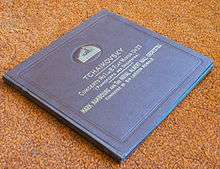
Ming (album)
Ming is the third album by David Murray to be released on the Italian Black Saint label and the first to feature his Octet. It was released in 1980 and features performances by Murray, Henry Threadgill, Olu Dara, Lawrence "Butch" Morris, George Lewis, Anthony Davis, Wilber Morris and Steve McCall.
Reception
The Rolling Stone Jazz Record Guide said "both Ming and Home display an excellent balance between written material and solos by a distinguished group of sidemen".
The Penguin Guide to Jazz selected this album as part of its suggested Core Collection.
The Allmusic review by Scott Yanow awarded the album 5 stars stating "His octet was always the perfect setting for tenor saxophonist David Murray, large enough to generate power but not as out of control as many of his big-band performances. Murray contributed all five originals (including "Ming" and "Dewey's Circle") and arrangements, and is in superior form on both tenor and bass clarinet. The "backup crew" is also quite notable: altoist Henry Threadgill, trumpeter Olu Dara, cornetist Butch Morris, trombonist George Lewis, pianist Anthony Davis, bassist Wilbur Morris, and drummer Steve McCall. These avant-garde performances (reissued on CD) are often rhythmic enough to reach a slightly larger audience than usual, and the individuality shown by each of these major players is quite impressive. Recommended.".

! (album)
! is an album by The Dismemberment Plan. It was released on October 2, 1995, on DeSoto Records. The band's original drummer, Steve Cummings, played on this album but left shortly after its release.
Track listing
Personnel
The following people were involved in the making of !:
References

"@" (album)
"@" is a studio album by John Zorn and Thurston Moore. It is the first collaborative album by the duo and was recorded in New York City in February, 2013 and released by Tzadik Records in September 2013. The album consists of improvised music by Zorn and Moore that was recorded in the studio in real time with no edits or overdubs.
Reception
Allmusic said "@ finds two of New York City's longest-running fringe dwellers churning out sheets of collaborative sounds that conjoin their respective and distinct states of constant freak-out... These seven improvisations sound inspired without feeling at all heavy-handed or urgent. More so, @ succeeds with the type of conversational playing that could only be achieved by two masters so deep into their craft that it probably feels a lot like breathing to them by now".
Track listing
All compositions by John Zorn and Thurston Moore

Album
Albums of recorded music were developed in the early 20th century, first as books of individual 78rpm records, then from 1948 as vinyl LP records played at 33 1⁄3 rpm. Vinyl LPs are still issued, though in the 21st century albums sales have mostly focused on compact disc (CD) and MP3 formats. The audio cassette was a format used in the late 1970s through to the 1990s alongside vinyl.
An album may be recorded in a recording studio (fixed or mobile), in a concert venue, at home, in the field, or a mix of places. Recording may take a few hours to several years to complete, usually in several takes with different parts recorded separately, and then brought or "mixed" together. Recordings that are done in one take without overdubbing are termed "live", even when done in a studio. Studios are built to absorb sound, eliminating reverberation, so as to assist in mixing different takes; other locations, such as concert venues and some "live rooms", allow for reverberation, which creates a "live" sound. The majority of studio recordings contain an abundance of editing, sound effects, voice adjustments, etc. With modern recording technology, musicians can be recorded in separate rooms or at separate times while listening to the other parts using headphones; with each part recorded as a separate track.

Ming the Merciless
Ming the Merciless is a character who first appeared in the Flash Gordon comic strip in 1934. He has since been the main villain of the strip and its related movie serials, television series and film adaptation. Ming is depicted as a ruthless tyrant who rules the planet Mongo.
Alex Raymond's comic strip
In the comic strip, when the heroic Flash Gordon and his friends land on the fictional planet Mongo, they found it was ruled by an evil Emperor, a despot who quickly becomes their enemy. He was not named at first, only being known as "the Emperor" until several issues later when his name was revealed to be Ming.
The capital of his empire is named Mingo City in his honour. In addition to his army, Ming is shown to have access to a wide variety of science fiction gadgets, ranging from rocket ships to death rays to robots. Though evil, he has his weaknesses, which include a desire to marry Flash's beautiful companion, Dale Arden. Ming's daughter Princess Aura is as evil as he is when the series begins, but is eventually reformed by her love for Flash, and later for Prince Barin of Arboria.
Podcasts:

